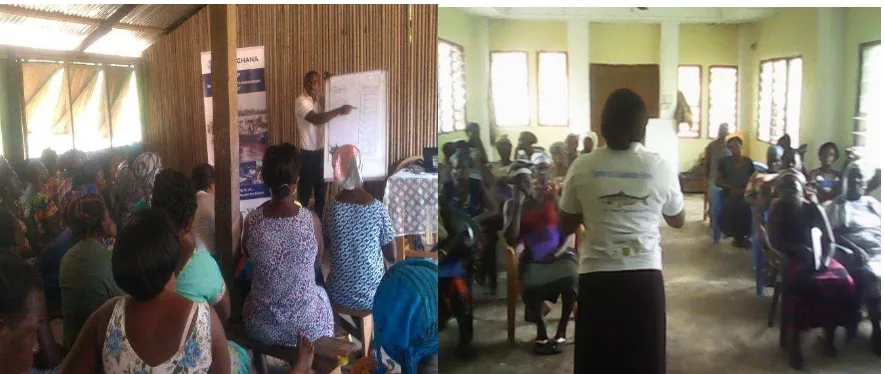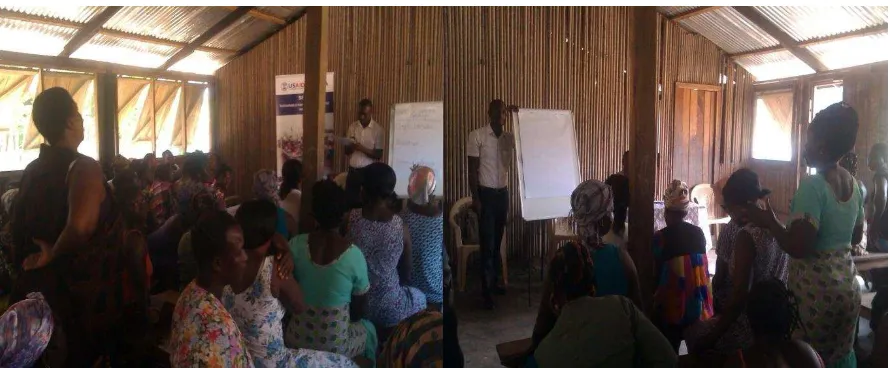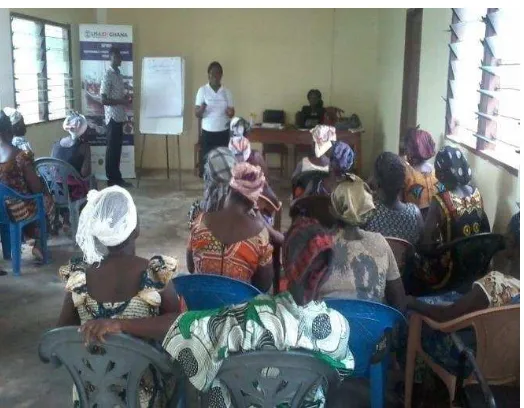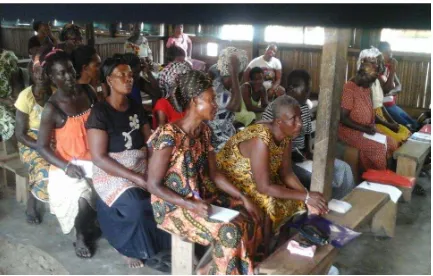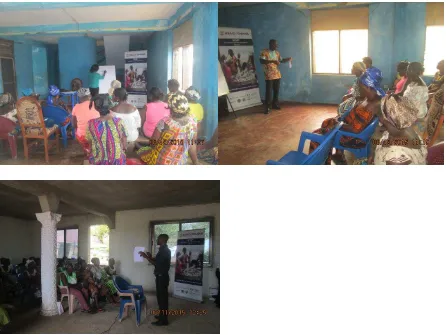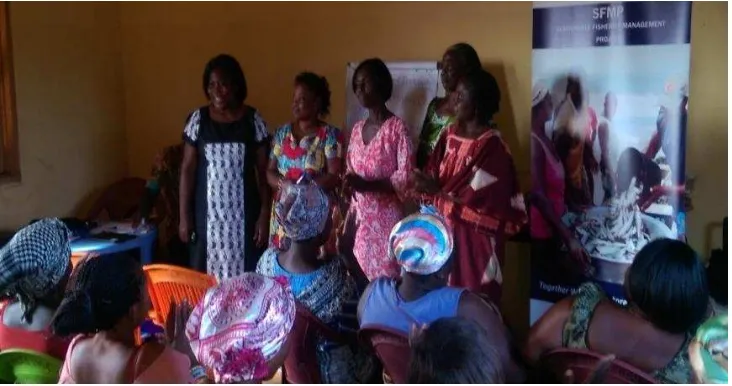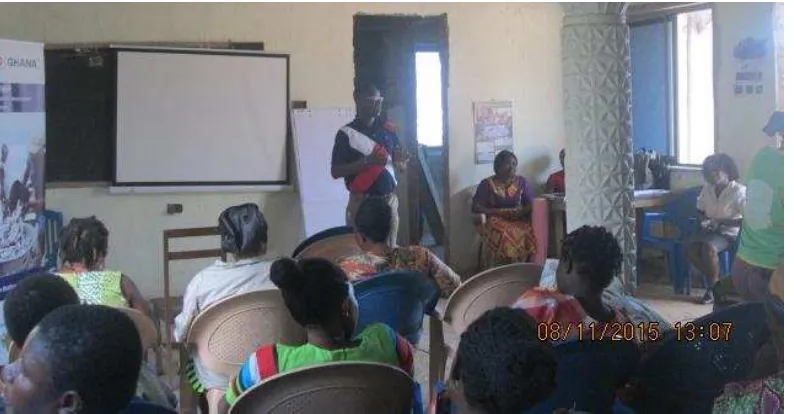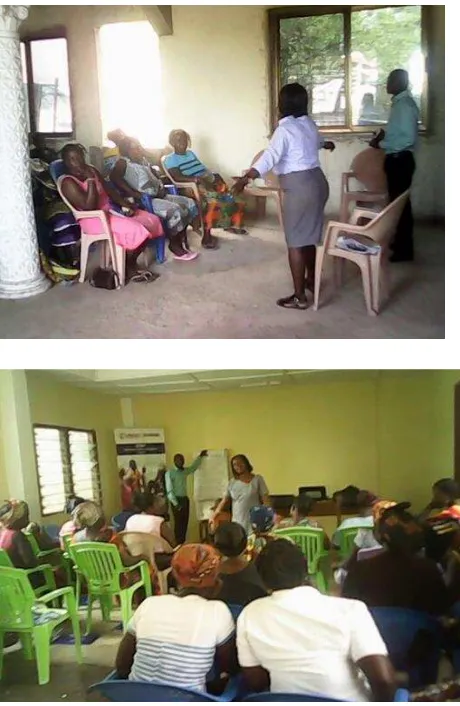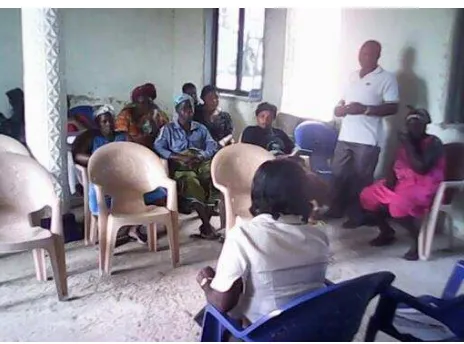SUSTAINABLE FISHERIES
MANAGEMENT PROJECT (SFMP)
MSME Training Report: Eight Week
MSME Training for Ankobra, Axim and
This publication is available electronically on the Coastal Resources Center’s website at http://www.crc.uri.edu
For more information on the Ghana Sustainable Fisheries Management Project, contact:
USAID/Ghana Sustainable Fisheries Management Project Coastal Resources Center
Graduate School of Oceanography University of Rhode Island
220 South Ferry Rd.
Narragansett, RI 02882 USA
Tel: 401-874-6224 Fax: 401-874-6920 Email: [email protected]
Citation: Swanzy, S. (2015). MSME Training Report: Eight Week MSME Training For
Ankobra, Axim and Shama Fisherfolks. The USAID/Ghana Sustainable Fisheries
Management Project (SFMP)Narragansett, RI: Coastal Resources Center, Graduate School of Oceanography, University of Rhode Island and Daasgift Quality Foundation.
GH2014_ACT009_DQF. 27 pp.
Authority/Disclaimer:
Prepared for USAID/Ghana under Cooperative Agreement (AID-641-A-15-00001) awarded on October 22, 2014 to the University of Rhode Island and entitled; the USAID/Ghana Sustainable Fisheries Management Project (SFMP).
Detailed Partner Contact Information:
USAID/Ghana Sustainable Fisheries Management Project (SFMP) 10 Obodai St., Mempeasem, East Legon, Accra, Ghana
Brian Crawford Chief of Party [email protected]
Najih Lazar Senior Fisheries Advisor [email protected]
Patricia Mensah Communications Officer [email protected]
Bakari Nyari Monitoring and Evaluation Specialist [email protected]
Don Robadue, Jr. Program Manager, CRC [email protected]
Justice Odoi USAID Administrative Officer Representative [email protected]
Kofi.Agbogah
SNV Netherlands Development Oganization #161, 10 Maseru Road,
E. Legon, Accra, Ghana 233 30 701 2440 Donkris Mevuta Kyei Yamoah
[email protected] Friends of the Nation Parks and Gardens Adiembra-Sekondi, Ghana 233 312 046 180
Peter Owusu Donkor Spatial Solutions
[email protected] #3 Third Nautical Close,
Nungua, Accra, Ghana
Darkuman Junction, Kaneshie Odokor Highway
Headmaster residence, Sekondi College Sekondi, Western Region, Ghana 233 243 326 178
For additional information on partner activities:
CRC/URI: http://www.crc.uri.edu
CEWEFIA: http://cewefia.weebly.com/
DAA: http://womenthrive.org/development-action-association-daa Daasgift:
https://www.facebook.com/pages/Daasgift-Quality-Foundation-FNGO/135372649846101 Friends of the Nation: http://www.fonghana.org Hen Mpoano: http://www.henmpoano.org
SNV: http://www.snvworld.org/en/countries/ghana SSG Advisors: http://ssg-advisors.com/
ACRONYMS
CEDECOM Central Region Development Commission
CEWEFIA Central and Western Region Fishmongers Improvement Association CLaT Child Labour and Trafficking
DAA Development Action Association DSW Department of Social Welfare FoN Friends of Nation
SFMP Sustainable Fisheries Management Program SNV Netherlands Development Organization
TABLE OF CONTENTS
Acronyms ... iii
Table of Contents ... iv
OBJECTIVE ...1
INTRODUCTION ...1
TERMS OF REFERENCE ...2
METHODOLOGY ...2
FINDINGS ...3
Week One ...3
Objective ...4
Expectation of participants ...4
Group dynamics/roles ...5 Figure 1 Percentage of MSMEs registered for training ...3
Figure 2 Training sessions in some of the venues (Ankobra and Shama) ...4
Figure 3 Some of the trainees sharing their expectations ...5
Figure 4 Trainees being taken through group dynamics ...6
Figure 5 Group leaders (Shama and Ankobra) giving a word of advice to their colleagues on the need to take their lessons serious. ...7
Figure 7 Participants being taken through the week’s topic (Shama, Ankobra and Axim) .9 Figure 8 Elected group leaders/ executives being applauded (from left: Executive Director of
Daasgift, The group president, treasurer, secretary and organizer; Axim- Fisheries) ...10
Figure 9 Mr. Amponsah from B.A.C addressing the class at Shama- Apo ...11
Figure 10 Training sessions in Axim and Ankobra ...12
Figure 11 Training sessions in Shama ...12
Figure 12 Some of the group members making contribution to the topic (Axim, Ankobra and Shama) ...14
Figure 13 (Top) Trainees making contributions to the topic. (Bottom): Participants engaging in an energizer ...15
Figure 14 Training sections in Shama, Axim and Ankobra...16
Figure 15 Training sessions in Axim and Shama ...17
Figure 16 Participants engaged in an energizer ...17
Figure 17 Training sessions (Axim, Shama)...18
Figure 18 Facilitator and trainee in a short skit on the topic being discussed ...19
Figure 19 Beneficiaries of MSMEs display inputs supplied after successfully completed 8 weeks of Business Development Training at Shama-Bentsir. ...20
DAASGIFTQUALITY FOUNDATION -FNGO
Community Development and Micro Finance Services
OBJECTIVE
The objective of the program is to mobilize resources through savings, financial management, planning, and credit activities with a view to improving the socio-economic conditions the community members for alternative livelihood.
REPORT ON MICRO, SMALL AND MEDIUM ENTERPRISE TRAINING
DATE: 1ST WEEK OF AUGUST to 1ST WEEK OF OCTOBER 2015
VENUE: SHAMA (BENTSIR AND APO), ANKOBRA (CATHOLIC SCHOOL) AND AXIM (BREWIE AND FISHERIES)
INTRODUCTION
In line with Daasgift-led fisheries value chain improvement and livelihoods in Western Region focusing on Ankobra and Pra estuary, an 8- Week MSME Training has been
(Shama-Apo), Wednesdays (Shama- Bentsir and Axim-Brewie and Fisheries) and Thursdays (Ankobra).
Generally, the weekly training programme began with a brief orientation of the project and its objectives. Participants in all the venues were also taken through the contents of the” SFMP song sheet”. A reminder of the topic treated on the previous meeting is normally done to enable participants be abreast with all the topics. Facilitation was also made easier with pictures and diagrams, which contributed to smooth and efficient running of the class. In order for the class to become lively, time was allowed for quick energizer by the class organizers. Time was also allocated for questions and contributions on the various topics. Attendance register was also used to monitor participants for the training programme.
TERMS OF REFERENCE
Total number of MSMEs registered for training
Week 1, topic - group dynamics,
Week 2, topic -roles and responsibilities of group leaders/ executives,
Week 3, topic- importance, formulation and adoption of regulations,
Week 4, topic - savings culture/savings procedure/savings mobilization,
Week 5, topic- business plan,
Week 6, topic - loans procedure,
Week 7, topic–financial literacy and records keeping,
Week 8, topic- safety and healthy fish handling,
Beneficiaries of Inputs after the training.
METHODOLOGY
Face to face / interactive training: The facilitators used marker boards, flip charts and projector for their teachings and presentations and as well allowed the training session to be more interactive were participants got chance to express their views and ask questions.
Group discussions: Participants were sometimes grouped for assignments and discussion to answer questions asked according to the manual with the help of the facilitator.
FINDINGS
Table 1 Total number of MSMEs registered for training
Name of Town Axim Shama Ankobra Total Number of MSMEs registered for training 81 55 68 204
Figure 1 Percentage of MSMEs registered for training
Week One
The first week training Program was organized on 4th, 5th and 6th August, 2015 in three towns namely Shama, Axim and Ankobra. The first program was held in Shama on 4th, followed by Axim and Shama on 5th and Ankobra on 6th August, 2015.
During the first week, participants shared their expectations for the training programme. They expected that at the end of the entire training programme, they should acquire knowledge in the following;
Knowledge in packaging Knowledge in savings New skills in smoking
Improvement in financial management skills Alternative livelihood skills
Knowledge in customer service Business management skills Improvement in financial literacy
The first week of the training also took participants through group dynamics. Some
characteristics such as open communication, understanding, unity, team work, tolerance and respect for one another were encouraged to be part of participants so as to ensure a smooth and efficient running of the training.
40%
33% 27%
Percentage of MSMEs registered for
training
Figure 2 Training sessions in some of the venues (Ankobra and Shama)
Objective
To take participants through group dynamics
Appoint class leaders and organizers who will see to the smooth running of the class.
To seek the general expectations of the fish processors as far as the training is concerned.
To set ground rules for the training program.
Expectation of participants
The program sought the general expectation of the trainees. At the end of the entire training program, trainees expect that knowledge and skills in the following areas would have been acquired:
Knowledge in packaging Knowledge in savings New skills in smoking
Improvement in financial management skills Alternative livelihood skills
Figure 3 Some of the trainees sharing their expectations
Group dynamics/roles
Trainees were taken through some characteristics that are required of a group in order for it to progress. The following were issues considered for discussion:
Team work Tolerance
Unity and oneness
Easy to approach one another Understanding
Figure 4 Trainees being taken through group dynamics
Ground Rules
Ground rules were also set out by the trainees, to guide them through the entire training program. These rules were agreed by the trainees to be followed strictly during training sessions.
No absenteeism without the necessary permission No lateness
All phones must be switched off or put on silent No movement during training sessions
Contributions in class must be encouraged Permissions and complaints
Figure 5 Group leaders (Shama and Ankobra) giving a word of advice to their colleagues on the need to take their lessons serious.
Lessons Learnt
The week one training gave the participants an insight on group dynamics. Trainees saw the need to tolerate one another as they pursue a common agenda. They shared their joy for being part of the training.
Week Two
The week two training programme was for the election of group leaders and executives who were charged to see to the smooth running of the training programme. It also enabled
participants to know the various leadership positions available and to decide on whom to vote for during election of the group leaders. The election of group leaders commenced soon after the positions available to be contested for was made known.
A Senior Business Advisor from Business Advisory Center (B.A.C) Shama was present on day one at Shama-Apo. He addressed the group and explained that the district assembly was aware and interested in the training and that they will take the participants through the technical aspect of the training.
The second week training program was organized on the 11th 12th and 13th of August 2015.
Figure 6 Trainees listening attentively and taking notes (Ankobra)
Objective
Figure 7 Participants being taken through the week’s topic (Shama, Ankobra and Axim)
THE VARIOUS LEADERSHIP ROLES IN A GROUP
The participants outlined a number of leadership positions, roles and qualities necessary in the administration of a group. The following were shortlisted for discussion:
The president:
Assumes leadership of the group Ensures the progress of the group
Represents the group to outsiders/ non- members Resolves conflicts in group
Ensures the internal rules/ regulations are respected and adhered to Must be honest, intelligent, reliable and dynamic
The secretary:
Gives accurate reports
Be well informed about group Take minutes at meetings Send invitations for meetings
Report group operations to relevant field officers
Capable of reading and writing, intelligent, attentive, regular and punctual at meetings The treasurer:
Ensures the security of group’s fund
Keeps an approved amount for emergencies
Must use group fund for approved transactions and avoid embezzlement of group’s fund
Must be able to count and calculate money Must be honest, reliable and conscientious The organizing secretary:
Mobilize members for meetings, events, etc. Ensure meeting place is in order
Collects fines where applicable
Must be energetic, smart, reliable, punctual and regular
The trainees were encouraged to use the knowledge acquired and the criteria they outlined in the election of the group leaders; to vote for people competent to help them achieve their group objective.
Figure 8 Elected group leaders/ executives being applauded (from left: Executive Director of Daasgift, The group president, treasurer, secretary and organizer; Axim- Fisheries)
Figure 9 Mr. Amponsah from B.A.C addressing the class at Shama- Apo
Lessons Learnt
Participants recognized the need for them to have leaders who will see to the smooth running of the training sessions. They were also keen on maintaining a decent record as one of the efficient and well organized class, which they said, will depend largely on the performance of their leaders. Therefore, they were happy to be involved in the election of class leaders.
Week Three
The third week training program was organized by Daasgift on the 25th, 26th and 27th of August 2015.
Figure 10 Training sessions in Axim and Ankobra
Objective
To take participants through the importance, formulation and adoption of regulations. To bring them to the knowledge of the importance that the group stands to gain when
it has its own regulations.
Lessons Learnt
The trainees understood the importance of regulations and so shared their joy after the week three training program, saying, they were very much delighted, having been able to formulate and adopt their own regulations which would guide.
Week Four
The fourth MSME Training Program was organized on 1st, 2nd and 3rd September, 2015 in three towns namely Shama, Axim and Ankobra. Day one was held in Shama on 1stand day two on the 2nd September in The topic treated for the week was savings culture/savings procedure/savings mobilization.
Figure 12 Some of the group members making contribution to the topic (Axim, Ankobra and Shama)
Objective
To take the trainees through the culture of savings.
To help participants understand the various steps that a person can take to make a successful savings plan.
To highlight the importance and the advantages of savings. Importance of savings
The trainees learnt the importance of savings, some of which were mentioned as follows;
It allows one to meet your basic household needs such as buying food and clothing for yourself as well as members of the family.
Savings increases one’s future potential to spend.
Prepares you to meet emergencies and unforeseeable events. Allows you to pay yourself before paying anyone else
Figure 13 (Top) Trainees making contributions to the topic. (Bottom): Participants engaging in an energizer
Lessons Learnt
After the training, the common misconception that savings is made after expenses are accounted for was removed. Group members in Shama made an agreement to commence a group saving scheme as soon as possible.
Week Five
The fifth week training was organized on the 8th 9th and 10th of September, 2015.
The topic for the fifth week was on business plan. The topic was to enable participants understand the need to have a business plan and to highlight the uses of a business plan and the advantages that could be derived from developing a business plan. It was also developed to help participants develop a simple business plan.
Objective
To enable participants understand the need to have a business plan. To help participants to develop a business plan.
Figure 14 Training sections in Shama, Axim and Ankobra
Lessons Learnt
The trainees were able to learn the steps involved in the development of a simple business plan. Some of the view shared after the program was that, prior to the training, they were ignorant on the need to have a business plan which they revealed, could have taken their business some steps further. Based on that revelation, the participants were given a template and charged to develop a simple business plan for presentation.
Week Six
The sixth MSME Training Program was organized on the 15th– 17th September, 2015 in three towns namely Shama, Axim and Ankobra.
Figure 15 Training sessions in Axim and Shama
Objective
The objective of the week six training program was to enable the trainees understand; The concept of loan
The importance and uses of loans.
Factors to considering deciding to take a loan and the implications of borrowing.
Topic Discussion
There was a discussion by the trainees on the definition of loan, which was explained as money borrowed for use and repaid to the owner being individual, group or financial
institution, after a defined time in the future, usually with interest or a fee charged for the use of the money.
Figure 16 Participants engaged in an energizer
Lessons Learnt
The lessons learnt by the participants at the end of the training program were the following;
A loan is not a gift, there is commitment to repay according to the agreed terms
Avoid multiple loans as this can lead to indebtedness
Only take a loan when you are sure of the reliability of source of repayment.
Week Seven
Week seven MSME Training Program was organized on 22ND, 23RD and 25TH September, 2015 in the various towns namely Shama, Axim and Ankobra.
The topic discussed in week seven was records keeping and financial game. The session also gave participants an insight into how to manage finances and the need for records keeping and continuous recording of transactions. This was also an interactive session in which participants were made to mention some of inflows and outflows and how to manage these in separate portfolios.
Objective
The objective of week seven training program was to:
Enable participants acquire knowledge in how to manage finances.
Help participants recognize the need for records keeping and constant recording of transactions.
Figure 17 Training sessions (Axim, Shama)
Figure 18 Facilitator and trainee in a short skit on the topic being discussed
Lessons Learnt
At the end of week seven training, participants understood the importance and the need to keep records on business transactions and also to keep an eye on business outflows so that the direction of the finances of the business could be kept on track.
Week Eight
The week saw the participants learning new ways of handling fish in a healthy manner which are expressed as follows. They realised the implications for the failure to handle fish in a healthy manner.
When working with fish it is important that appropriate handling and storage are used to reduce the risk of food-borne illness and ensure a quality product. You cannot see the harmful bacteria on the fish so you must handle it as if it is present. Salmonella and E. coli are
bacteria that can cause food-borne illness and are sometimes found on fish. Follow the guidelines below to ensure safety against food-borne illnesses when handling fish.
Contamination Prevention
Cleanliness: A clean working environment is essential in the prevention of contamination when working with fish. Be sure to wash hands thoroughly before and after handling raw fish. The work area, cutting boards, and utensils must be thoroughly cleaned with hot soapy water after being exposed and should not be used for other foods until properly cleaned. This will prevent cross contamination of bacteria from the fish to other foods.
after each use and periodically cleaned with a bleach solution consisting of 1 tablespoon of bleach per gallon of water.
Handling Market Fish: Fresh or frozen fish should be purchased just before leaving the market so it is exposed to unsafe temperatures for as short a time as possible. It should be placed in a plastic bag to prevent any leakage from contaminating any other foods. Bring a cooler along to store the fish in while traveling home or pack the fish in ice. To maintain the quality of the fish, it needs to be kept at a temperature under 40°F. Do not allow the fish to set in a hot vehicle for any length of time unless stored properly. After purchasing it should be taken home and refrigerated as soon as possible.
Lessons Learnt
1. Fishes should never be put on the bare ground
2. Platform or boards need to be used for cutting large fishes.
3. Aprons and scarfs need to be put on when smoking.
4. Utensils need to be washed with soap and hot water thoroughly as well as hands.
5. Working environment need to be kept neat at all times
Beneficiaries of inputs
Daasgift has supported 23 MSMEs with inputs to aid in their business operations
Figure 19 Beneficiaries of MSMEs display inputs supplied after successfully completed 8 weeks of Business Development Training at Shama-Bentsir.
CONCLUSIONS
The eight week training program was successfully held in all the three towns; Axim, Shama and Ankobra. It was one of the exciting training programs because it became an eye-opener for the participants on the need to have a business plan. The training was well organized in all the venues.
Leaders were allowed to give their views on the program and to our amazement they wish for us to extend the date.
RECOMMENDATIONS
More of such training can be organized to help the fisher folks and enlighten them on certain issues applying to their businesses.
The NGO’s engagement in Micro, Small and Medium scale Enterprises should be a continual commitment which should even involve mostly the youth in the coastal regions and more especially youth fisher folks for them to be employable and as a way ease the huge burden on the sea.
NGO’s can also improve the venue or centers where community meetings and trainings are held as part of aiding development.

